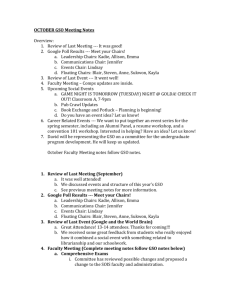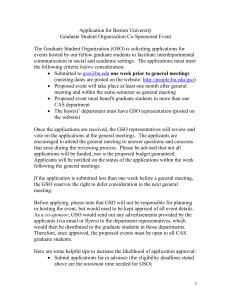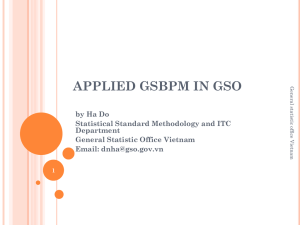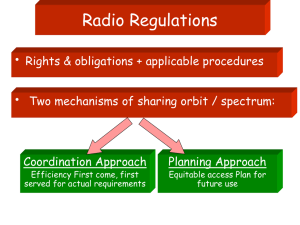Information and IT architecture development
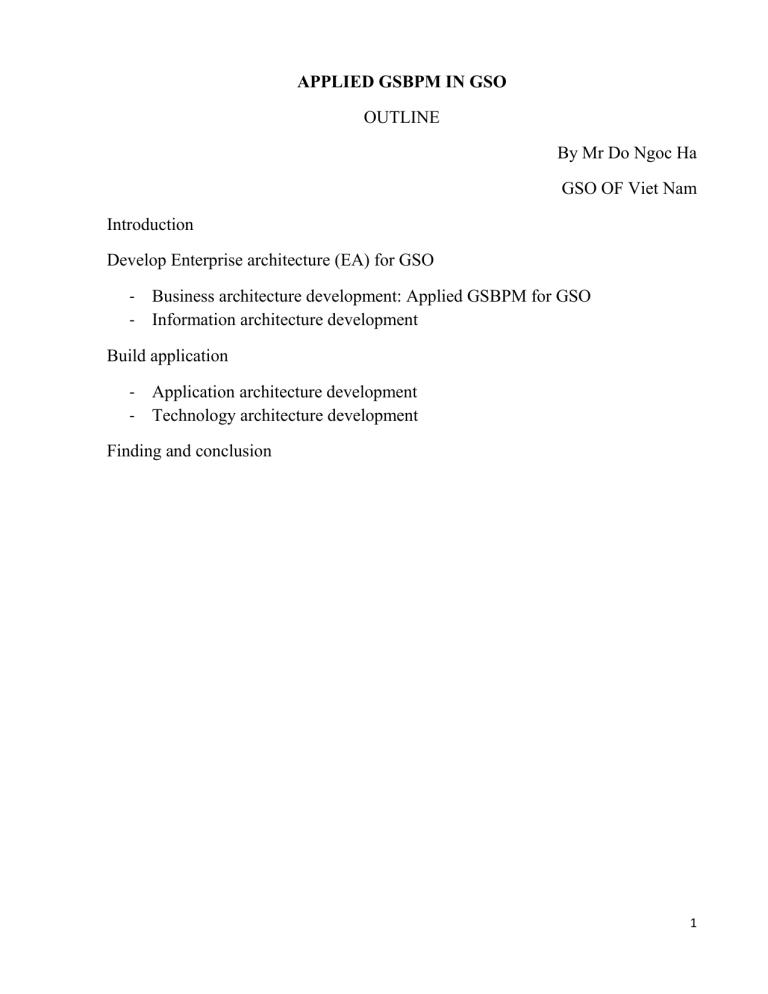
APPLIED GSBPM IN GSO
OUTLINE
By Mr Do Ngoc Ha
GSO OF Viet Nam
Introduction
Develop Enterprise architecture (EA) for GSO
Business architecture development: Applied GSBPM for GSO
Information architecture development
Build application
Application architecture development
Technology architecture development
Finding and conclusion
1
The GSO vertical structure is supportive of consistent statistical management from central to local levels (HQ, 63 PSOs and 708 DSOs). There is clear specification of responsibilities between the GSO and other institutions contributing to the Vietnam Statistical System as specified in National statistical indicator system (NSIS). Data collection systems through reporting regimes, sample surveys (43 surveys was conducted by GSO every year) and administrative records are well developed. GSO is adopting International standards in many fields of Statistics. Strong in certain statistical methodologies that is: available methodologies for most domains; metadata definition follows standards and is largely in compliance with General Data Dissemination System.
However, GSO has inherited weaknesses related to statistic production process; there are deficiencies in the implementation of the data collection systems, and technical aspects of statistical work, each department has its own collection methods and no standardized data between survey forms. The system of classifications is the weakest element among statistical tools for the development of data production, dissemination and analysis. Difficulties in the process of development of databases including data (micro and macro databases) and metadata. GSO departments working in silos – difficult to share and integrate data across departments. Lack of systematic process to integrate data across GSO departments.
Following “
Vietnam Statistical Development Strategy 2011-2020 and Vision to 2030”.
In 2011, GSO had a bidding package to build Enterprise Architecture
(EA) under supported of WB; EA was applied base on OIO framework to built BA
– business architecture, IA – information architecture, TA – technical architecture and AA - application architecture follows four strategies: (i) Metadata-Driven
Statistical Production; (ii) One Centralized Virtual Database; (iii) Synchronized
Data Collection; (iv) Intelligent Statistical Analysis and Modeling.
Business architecture development - BA( Applied GSBPM for GSO ) : 2011,
GSO setups Core team includes key persons from all departments to work with the
EA contractor, including:
Population and Labour Statistics Department
Agriculture, Forestry and Fishery Statistics Department
Industrial Statistics Department
Construction and Investment Capital Statistics Department
2
Trade and Service Statistics Department
Price Statistics Department
Socio-Environmental Statistics Department
National Account Department
Integrated Statistics Department
Statistical Standard Methodology and IT Department
Core team and EA contractor had reviewed business process of all surveys in all departments. At high level, statistical processes are quite similar across all departments and consists 5 steps: (1) Survey Preparation / Formulation; (2) Data
Collection; (3) Data Processing; (4) Data Analysis; (5) Information Dissemination.
Eurostat SBPM version had been choosing as the international standard reference.
The GSO SBPM was designed for all surveys in GSO include sample surveys as well as Census with sub-processes were indicated and order to cover all steps and suitable with all survey domains. In the first phase, this model was designed for all surveys in National survey program; next phase, the model will be reviewing in the future for other statistic sources such as the integrated report regimes and administrative records. In order to support effectively GSO strategies and the BA, the processes model relating to the statistical production lifecycle is metadatadriven.
3
Identify needs
Collect and consolidate information needs, check available information
Identify information need to be collected
Develop survey sample frame*
Prepare collection
Develop survey plan*
Build metadata
Quality management/ Metadata management
Data collection
Interview for data collection
Correct data
Create output template
Code and classify data
Review survey plan
Consolidate collected data
Conduct survey training
Input data
Data processing
Perform data cleaning and verification
Calculate and integrate data
Calculate weight
Data analysis
Analyze entire survey data
Calculate report
Verify survey result
Produce final report
Information dissemination
Draft publishing report
Review publishing report
Publish statistical product
Archive
Restore survey data*
Conduct evaluation of process*
Conduct evaluation of end users
1) Identify needs i.
Collect and consolidate information needs, check available information; ii.
Identify information need to be collected; iii.
Develop survey sample frame: identify objective and scope of information, design sample survey;
2) Prepare collection i.
Develop survey plan –survey methodologies; design questionnaire; choose the data collection method; built resource plan (finance, human, equipment), checking and supervisory plans, pilot if any; ii.
Build metadata: refer to metadata on previous survey plans iii.
Create output template iv.
Review survey plan – refer to metadata checklist and ensure that all details are included v.
Conduct survey training
3) Data collection i.
Interview for collecting data & supervise
4
ii.
Correct data iii.
Code and classify data iv.
Consolidate collected data v.
Input data
4) Data processing i.
Perform data cleaning and verification ii.
Calculate and integrate data iii.
Calculate weight
5) Data analysis i.
Analyze entire survey data ii.
Calculate report iii.
Verify survey result iv.
Produce final report
6) Information dissemination i.
Draft publishing report ii.
Review publishing report iii.
Produce and publish statistical product including the soft copy (GSO website)
7) Archive i.
Restore survey data: except restore survey data after data entry and process, analysis, step; purpose to category data and build data warehouse to support search statistic information. This step also digitalizes statistic information in document format by using Data Document Initiative - DDI protocol. The questionnaires of several surveys were digitalizing when the data entry is used scanning technology. ii.
Conduct evaluation of process iii.
Conduct evaluation of end users
Several sub-steps were customized to suitable with GSO, metadata building step is focused to ensure data linkage and no conflict data between the difference survey data. Some steps are putted in the third step such as correct data, code and classify data steps instead of put in data processing step. Because the third step is done by statistician without IT skill, the fourth step is done by IT skill persons but
“input data” step is in the third step to suitable with both of the data collection ways that is classic way and supported mobile divide way.
Information and IT architecture development - IA : statistic information is owner in difference department and was supported by more than 35 silo applications and many of them execute similar sets of business processes, and these applications have no integration. Statistic information needs to be standardized, centralized and follow unique information flow under GSBPM. GSO had chosen
GSIM as approach to implement. Metadata-driven is the way to standard statistic
5
indicator and information across difference domains to improve communication between the difference steps of statistic production, organization and sharing micro, macro data between domains.
Therefore, GSO departments and PSOs should interface to just ONE (1) GSO
IT system. This is the reason for the introduction of a configurable workspace application (CWA). CWA is a virtual workspace function wherein each GSO department/PSO is given access to its own segment of the GSO Integrated
Applications System, which contains all applications contained in the green box illustrated below. The virtual workspace shares the same meta-application but each is configurable to fit the user needs. Data are also allocated to each application segment with controlled access privileges to ensure data privacy while still maintaining the integrated data system at the database level. These virtual workspaces can be created, deleted and controlled from a single management interface.
6
Application architecture development - AA : the GSO AA has the purpose of designing the best architecture alternatives to serve GSO Business needs. AA indicate the principles that affected the development, maintenance, and use of the enterprise architecture; related guidance for designing and developing information systems. Three most significant important principles are: (1) Open, service-oriented
Application Architecture; (2) Meta-data driven; (3) One Centralized Virtual
Database. AA has chosen DDI and SDMX standards as approach to develop the statistic application.
AA created a GSO integrated IT platform framework. All users will interface via the unified Configurable Workspace Applications and Portal. All applications will be hosted here. All data will be hosted in GSO Integrated Data Store and available via Data Services. System administration is centralized via the use of
Common Communication Services.
GSO built the System of statistic information collection (SSIC) and Statistical
Hub (SH) application to supported all step in the GSBPM.
7
This figure describe work flow of application supported GSBPM, the application including 2 main components that are System of statistic information collection (SSIC) and Statistical Hub (SH).
SSIC supports three first steps:
Identify needs (accept metadata management, that is done in SH and integrated with SSIC)
Prepare collection
Data collection
Data entry form designing is simple way as drop down questions to questionnaire and is done by statistician without IT skill. Data entry will be inputted online by PSO (province level)
SH supports fourth last steps:
Data processing
Data analysis
Information dissemination
8
Archive
All survey data is centralizes, system help end user share data easily between domains and between departments. Report is public directly through intranet portal after validate.
Technology architecture (TA) development : describes the technology components and platforms used as reference in building the GSO IT Infrastructure.
The process of deriving the TA involves correlating information that has been built up in the Business, Information and Application Architecture analyses.
TA develops Technical Reference Model that is a hierarchical model used to categorize and classify available technologies. Each service defines the group standards and technologies that can be using in GSO.
Finding and conclusion
1) Establish the Core team include key person from all difference department who understand current business process to give situation and problem need to be improve.
2) Choose the Model as reference and customize, at this time we have chosen
Eurostat GSBMP. Version 5.0 was released in 2013
3) Request to have application support all main step of GSBPM to keep union business process between difference domains and difference departments.
4) Standardize the statistic data is the focus of work and takes time.
5) Metadata-driven is the key to connect all component and statistic indicators therefore we can share data and communicate more easily.
9



